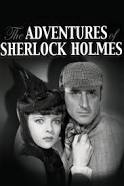
“I have encountered only one man whom I can truthfully call the very genius of evil.”
Professor Moriarty (George Zucco) manages to be acquitted of murder. Sherlock Holmes (Basil Rathbone) has proof of his guilt but arrives too late. Moriarty, now free, has devised what he calls the crime of the century and in accomplishing it will discredit Holmes.
Sir Ronald Ramsgate (Henry Stephenson) is in charge of guarding the crown jewels. He is expecting a delivery of a gem called The Star of Delhi. He receives a note that says it will be stolen. He asks Holmes to ensure the delivery of the jewel. Holmes agrees.
Next Ann Brandon (Ida Lupino) calls on Holmes and Doctor Watson (Nigel Bruce). She tells him that her brother Lloyd (Peter Willes) has received a strange note. It was a drawing of a man with an albatross hanging around his neck. She says her father received an identical one just before he was murdered ten years ago. A family friend and family attorney, Jerrold Hunter (Alan Marshal), shows up and tries to convince Holmes that there is nothing to the note. Holmes believes the note is a dire warning and rushes to find Lloyd Brandon. He finds Lloyd too late. He has been strangled and his skull was crushed.
Holmes believes that Ann is now in danger. He firmly believes that Moriarty is behind the murder and is a threat to Ann. Holmes goes under cover to protect her. In the meantime he has neglected his other case. The Star of Delhi.
“The Adventures of Sherlock Holmes” was released in 1939 and was directed by Alfred L. Werker. It was the second of the 14 Sherlock Holmes movies that stared Basil Rathbone and Nigel Bruce. It is also the second and final movie produced by 20th Century Fox. The remaining 12 movies by the Rathbone/Bruce duo were produced by Universal. It is also the second and last of the 14 that take place in the original Victorian Era of the story. It is also the first of 3 of the 14 that features Professor Moriarty.
Supposedly the film is based on the 1899 stage play done by William Gillette. William Gillette is reputed to be the quintessential Holmes and is credited with many of the characteristics that are associated with the character. Gillette played Holmes on stage and in a 1916 silent film titled “Sherlock Holmes”. The film was thought to be lost until 2014. The quote "Elementary, my dear Watson" was first used the 1929 talkie “The Return of Sherlock Homes” with Clive Brook. It was never in any of Doyle’s stories, although once Holmes said, in "The Adventure of the Crooked Man", "Elementary".
Sir Arthur Conan Doyle modeled his detective after one of his medical school professors, Dr. Joseph Bell. Bell was a Scottish surgeon and lecturer at the medical school of the University of Edinburgh in the 19th century.
The movie co-stars Ida Lupino as Ann Brandon. Ida was well known as an actor, director and writer. She did most of her directing during the 50’s and 60’s, a time when women were not prominent in the field. She has 41 directing credits to her name. She wrote 8 screenplays and TV episodes and produced two movies. She was one of a very small club of women who were well respected for their contributions to film and TV.

